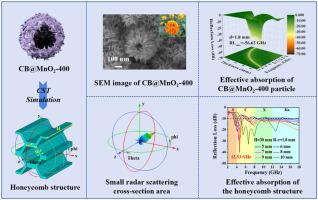雷达-红外双隐身超宽带蜂窝吸收体中空花状CB@MnO2的简化制作
IF 11.6
2区 材料科学
Q1 CHEMISTRY, PHYSICAL
引用次数: 0
摘要
电磁波吸收材料的发展需要优异的吸收性能和雷达-红外隐身兼容性。我们首创了一种简化的水热煅烧策略,仅使用炭黑(CB)和高锰酸钾(KMnO4)作为前体,合成具有红外隐身兼容性的轻质空心花状CB@MnO2-400复合材料。此外,本研究探索了将粉末材料集成到蜂窝结构中,通过仿真驱动设计,有效地拓宽有效吸收带宽(EAB),增强其在各种场景下的通用性。煅烧温度对CB@MnO2的微观结构进行了调节。在厚度为1.8 mm时,CB@MnO2-400的最小反射损耗(RLm - l - n)为−56.62 dB, EAB为5.84 GHz。值得注意的是,它展示了双功能隐身,雷达横截面(RCS)降低37.6 dB m2(在100度时)和高红外反射率(远红外区0.57)。CB@MnO2-400具有优异的EMWA性能和雷达-红外兼容性是多种损耗机制的综合作用和其独特的空心花状形态。此外,利用CST电磁仿真软件设计了基于CB@MnO2-400的宏观蜂窝状结构吸波器,将EAB扩展到12.53 GHz。该研究为优化碳锰材料的微观结构和宏观结构以增强EMWA和红外隐身性能提供了新的见解,解决了当前文献中的重大空白。本文章由计算机程序翻译,如有差异,请以英文原文为准。

Simplified fabrication of hollow flower-like CB@MnO2 for radar-infrared dual-stealth and ultra-broadband honeycomb absorber
The development of electromagnetic wave absorption (EMWA) materials needs excellent absorption performance and radar-infrared (IR) stealth compatibility. We pioneered a simplified hydrothermal-calcination strategy to synthesize lightweight hollow flower-like CB@MnO2-400 composites with IR stealth compatibility using only carbon black (CB) and potassium permanganate (KMnO4) as precursors. Furthermore, this study explores the integration of powder materials into honeycomb structures, enabled by simulation-driven design, to effectively broaden the effective absorption bandwidth (EAB) and enhance their versatility in various scenarios. The microstructure of CB@MnO2 was adjusted by the calcination temperature. At a thickness of 1.8 mm, CB@MnO2-400 exhibited an minimum reflection loss (RLmᵢn) of −56.62 dB, accompanied by an EAB of 5.84 GHz. Notably, it demonstrates dual-functional stealth with a radar cross-section (RCS) reduction of 37.6 dB m2 (at 10o) and high infrared reflectivity (0.57 in far-infrared region). The remarkable EMWA performance and radar-infrared compatibility of CB@MnO2-400 are attributed to the combined effects of various loss mechanisms and its distinctive hollow flower-like morphology. Additionally, a macroscopic honeycomb-structured absorber based on CB@MnO2-400 was designed using CST electromagnetic simulation software, extending the EAB to 12.53 GHz. This study offers novel insights into optimizing both the microstructure and macrostructure of carbon-manganese materials for enhanced EMWA and infrared stealth performance, addressing a significant gap in the current literature.
求助全文
通过发布文献求助,成功后即可免费获取论文全文。
去求助
来源期刊

Carbon
工程技术-材料科学:综合
CiteScore
20.80
自引率
7.30%
发文量
0
审稿时长
23 days
期刊介绍:
The journal Carbon is an international multidisciplinary forum for communicating scientific advances in the field of carbon materials. It reports new findings related to the formation, structure, properties, behaviors, and technological applications of carbons. Carbons are a broad class of ordered or disordered solid phases composed primarily of elemental carbon, including but not limited to carbon black, carbon fibers and filaments, carbon nanotubes, diamond and diamond-like carbon, fullerenes, glassy carbon, graphite, graphene, graphene-oxide, porous carbons, pyrolytic carbon, and other sp2 and non-sp2 hybridized carbon systems. Carbon is the companion title to the open access journal Carbon Trends. Relevant application areas for carbon materials include biology and medicine, catalysis, electronic, optoelectronic, spintronic, high-frequency, and photonic devices, energy storage and conversion systems, environmental applications and water treatment, smart materials and systems, and structural and thermal applications.
 求助内容:
求助内容: 应助结果提醒方式:
应助结果提醒方式:


